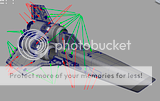Dave,
This model has a combination of smoothed and unsmothed parts. The nose section, canopy, engines, engine casing, raised panels are unsmoothed and I use soft/harden edges with a smoothing angle of 35 degrees and then hand tweak a few edges.
To avoid render artifacts I use a multi-segment bevels on the rounded edges with sufficient segments to look smooth from the distance most shots would be made from. I put single segment bevels on all the things with tight angles to give a more natural chamfered look to the edges.
The wings, tail, front nacelles, some of the greebled bits are smoothed.
Anything that can be built from a simple cage with edges that I easy to tighten by adding edge loops or 2-segmant bevels I generally smooth.
I could smooth everything. But for some things with hatches and cutouts with tight corners smoothing can be difficult because in order to add the edges to tighten the corners you have to propagate those edges all around the model. Then you have to either try to spread them out without introducing lumps and bumps in your surfaces and to avoid creases and visible rendering artifacts all around your model. Or option two, you have to split the model up into panels to localize the edges used to tighten the corners to smaller areas. This introduces surface continuity problems where panel edges meet with different numbers of butted edges.
So when do I make the decision to go unsmoothed?
I can't say how it works in a studio but for me , I try build everything so that it can be smoothed.
If something is smoothed I don't have to worry about softening or harding edges, render artifacts around curves for close shots (because you can always just crank up the number of divisions), razor sharp cg looking edges are eliminated.
However, the price you pay for smoothing is if your geometry has cutouts and things with tight edges and corners it can become bothersome to smooth the part without getting creases or messing up your surfaces, or getting surface continuity problems.
The reason I have not smoothed the parts I have is:
1. The canopy is hinged and integrated in with the back part which I extruded out of the canopy, smoothing caused surface continuity problems and I did not want to bother taking the time to resolve, so I wimped out and just went with multi-segment bevels. I will probably come back and remodel the entire canopy to be smoothed, because the corners are looking to sharp to me as they are and to bevel them it becomes as much work as just rebuilding them to be smoothable.
2. The rear engine casing, has the trapezoidal section extruded from it and trying to keep it integrated casuses creases and separating it makes me have to add edges to sharpen corners to maintain continuity, so I did not think the added polygon weight was worth it.
3. As for the engines, to tighten up the raised panel corners I would destroy the cylinder with creases and non-planer polygons. Although I could just make all the panels separate parts and just stuff them into the geometry. This is what I did on the tails and wing.
4. The nose section, after cutting in all the geometry to make everything quads to show people that you can actually change geometry after booleaning it (lol), is now close to smoothable. But I would have to do some work around the area with the missile door cutouts.
I can't put arrows on everything but the GREEN arrows point to objects that are smoothed and the RED arrows are parts that are not smoothed and I use soft/harden edge and beveling. You can tell smoothed from unsmoothed parts where you see something that has all softened edges (dashed lines) and tight corners with hig concentrations of edges.

"If I have seen further it is by standing on the shoulders of giants." Sir Isaac Newton, 1675
Last edited by ctbram; 03-01-2010 at 06:39 PM.